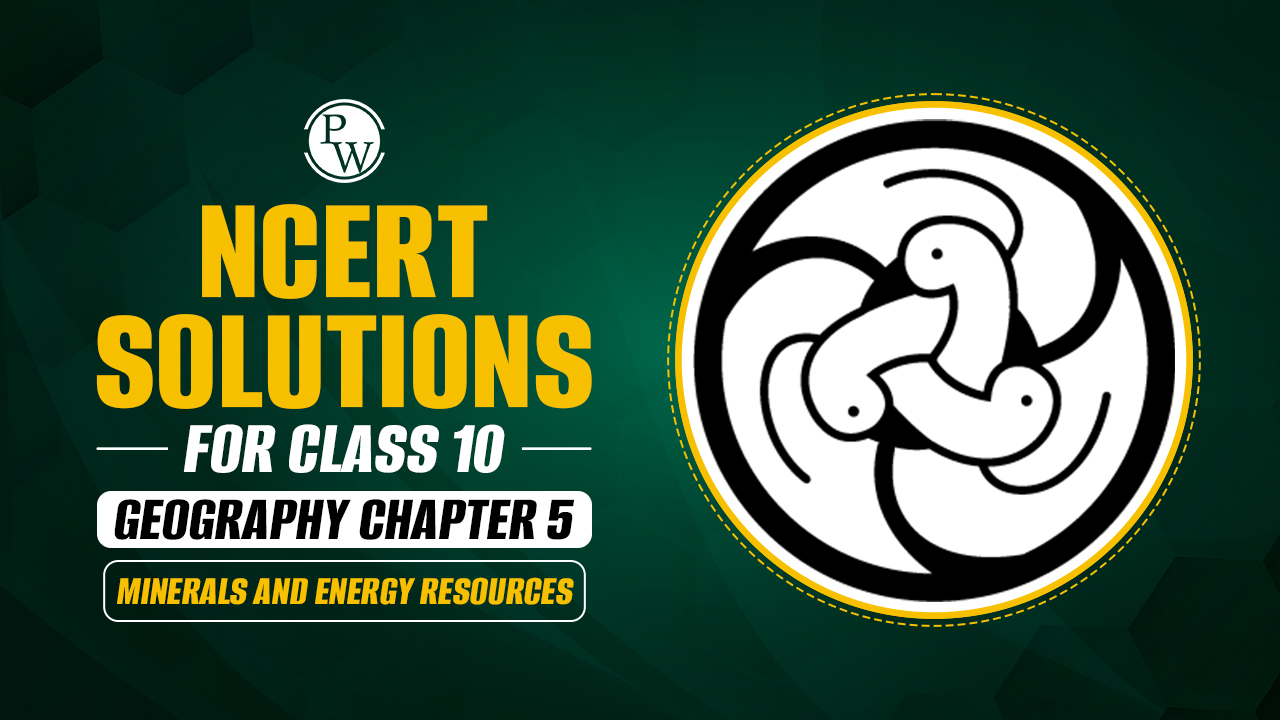NCERT Solutions for Class 10 Geography Chapter 5 - Minerals and Energy Resources

NCERT Solutions for Class 10 Geography Chapter 5 - Minerals and Energy Resources:- If you're preparing for your Class 10 Geography exam, the NCERT Solutions for Chapter 5: Minerals and Energy Resources is a great help. This chapter explains the different types of minerals and energy resources, where they are found, and how they are used in our daily lives. It covers important topics like the classification of minerals, how we extract them, and the role of energy resources like coal, oil, and renewable sources such as wind and solar energy.
By going through the minerals and energy resources Class 10 questions and answers, you'll better understand the chapter and feel more confident about your exam. The Class 10 Geography Chapter 5 question answer section provides simple and clear explanations, making it easier for you to understand key concepts. The minerals and energy resources Class 10 solutions are a great way to check your answers and ensure you’re on the right track. With these solutions, you can prepare well and tackle your exam with confidence.
Check out: CBSE Class 10th Books
Minerals and Energy Resources Class 10
If you're looking for NCERT Solutions for Class 10 Geography Chapter 5: Minerals and Energy Resources, Physics Wallah has got you covered with clear and easy-to-understand solutions. This chapter talks about different types of minerals, how they are used, and the importance of energy resources like coal, oil, and renewable sources such as wind and solar power.
The Class 10 Geography Chapter 5 solutions from Physics Wallah explain each question step-by-step, making it simple to follow and learn. Whether you need help with minerals and energy resources Class 10 solutions or want to practice more, these solutions will guide you through everything and help you prepare well for your exams.
Check out: CBSE Class 10th Sample Papers
NCERT Solutions for Class 10 Geography Chapter 5 - Minerals and Energy Resources
Exercises
1. Multiple choice questions.
(i) Which mineral is created when rocks break down and leave behind a residual mass of weathered material?
(a) Coal (b) Bauxite (c ) Gold (d) Zinc
Solution: (b) Bauxite
Read More: Class 10 Geography Chapter 1 Question Answer
(ii) Of these minerals, which one is the most produced in Koderma, Jharkhand?
(a) Bauxite (b) Mica (c ) Iron Ore (d) Copper
Solution: (b) Mica
Read More: Class 10 Geography Chapter 2 Question Answer
(iii) Which of the following rocks has layers where minerals are deposited and accumulated?
(a) Sedimentary Rocks (b) Metamorphic Rocks
(c ) Igneous Rocks (d) None of the above
Solution: (a) Sedimentary Rocks
(iv) Which one of the following minerals is contained in the Monazite sand?
(a) Oil (b) Uranium (c) Thorium (d) Coal
Solution: (c) Thorium
Read More: Class 10 Geography Chapter 3 Question Answer
2. In roughly thirty words, respond to the following questions.
(i) Within a maximum of thirty words, differentiate between the following.
-
Ferrous and non-ferrous minerals
-
Conventional and non-conventional sources of energy
Solution: Metallic minerals that contain iron are known as ferrous minerals. For instance, cobalt, nickel, manganese, iron ore, etc.
Non-ferrous minerals lack iron yet are nevertheless metallic. For instance, copper, zinc, gold, etc.
b. Firewood, cattle dung cake, coal, petroleum, natural gas, and electricity (both thermal and hydel) are examples of conventional energy sources.
On the other hand, unconventional energy sources include atomic, solar, wind, tidal, geothermal, and biogas energy.
(ii) What is a mineral?
Solution: One way to characterise homogenous, naturally occurring materials with a definite internal structure is as minerals.
Read More: Class 10 Geography Chapter 4 Question Answer
(iii) How do minerals in metamorphic and igneous rocks form?
Minerals can be found in the fissures, joints, fractures, and crevices of igneous and metamorphic rocks. Larger deposits are referred to as lodes, and lesser ones as veins.
(iv) Why do we need to conserve mineral resources?
Solution: In the earth’s crust, mineral deposits make up just 1%. Because the geological processes of mineral production are so slow, the rates of replenishment are relatively low compared to the current rate of consumption, which is why we need to safeguard mineral resources.
3. Provide a 120-word response to each of the following questions.
(i) Describe the distribution of coal in India
Solution: Coal is found in rock series in India that belong to the two main geological ages:
-
Gondwana (200 million years old)
-
Tertiary deposits (55 million years old)
The major resources of Gondwana coal are located in:
-
Damodar Valley (West Bengal – Jharkhand) – Jharia, Raniganj and Bokaro are important coalfields.
-
Godavari valley
-
Mahanadi valley
-
Son valley
-
Wardha valley
(ii) What makes you believe that India will be a successful market for solar energy?
India, being a tropical nation with vast potential for solar energy utilisation, has a bright future for solar energy. In isolated and rural locations, solar energy is quickly gaining popularity. Milk cans are sterilised using solar radiation at Madhapur, close to Bhuj, which is home to India’s largest solar power facility.
It is anticipated that using solar energy will be able to reduce rural communities’ reliance on dung cakes and firewood, which will help preserve the environment and ensure that there is a sufficient supply of manure for agriculture.
One unconventional but renewable energy source is solar energy. Not only will solar energy use benefit the environment, but it will lessen our reliance on petrol and oil.
Check out: CBSE Class 10th Previous Year Papers
Class 10 Geography Chapter 5 Notes
In Class 10 Geography Chapter 5: Minerals and Energy Resources, the following topics will be covered in detail to help students better understand the different types of minerals and energy resources, as well as their importance and usage. Here's a breakdown of each topic:
1. What is a Mineral?
-
A mineral is a naturally occurring substance found in the earth's crust. They are inorganic solids and have a specific chemical composition. Minerals are important raw materials for industries and play a crucial role in various daily life products.
2. Mode of Occurrence of Minerals
-
Minerals occur in different forms in the earth's crust. They may be found in veins, lumps, crystals, or even as ores. The occurrence of minerals depends on geological conditions like temperature, pressure, and chemical processes that took place millions of years ago.
3. Ferrous Minerals
-
Ferrous minerals contain iron and are used mainly in the manufacture of steel. Common ferrous minerals include iron ore (like hematite and magnetite), manganese (used to make steel), and chromite (used in the production of steel).
4. Non-Ferrous Minerals
-
Non-ferrous minerals do not contain iron. These minerals are important in industries for producing products such as electrical cables and jewellery. Examples include bauxite (used to make aluminium), copper (used in electrical wiring), and gold (used for jewellery and coins).
5. Non-Metallic Minerals
-
Non-metallic minerals do not contain metals and are used in a variety of applications. Mica, limestone, salt, and gypsum are examples. These minerals are used in industries like construction, electronics, and food processing.
6. Rock Minerals
-
Rock minerals are those found in rocks and are used in the extraction of other minerals. These include minerals like quartz, feldspar, and mica, which are used in glass and ceramics manufacturing.
7. Conservation of Minerals
-
Conservation of minerals refers to the responsible use and management of mineral resources to prevent over-exploitation and depletion. Sustainable mining practices, recycling, and reducing waste are some ways to conserve minerals for future generations.
8. Energy Resources
-
Energy resources are sources of energy that we use for power generation, heating, and transport. These resources are either renewable (like wind and solar) or non-renewable (like coal and petroleum).
9. Conventional Sources of Energy
-
Conventional sources of energy are the traditional sources of energy that have been used for centuries. These include:
-
Coal: A fossil fuel used in power plants and for heating.
-
Petroleum: Also known as crude oil, it is refined into products like gasoline, diesel, and kerosene.
-
Natural Gas: A clean and efficient fossil fuel used for heating, electricity, and cooking.
-
Electricity: Generated from sources like coal, hydroelectric power, and nuclear energy.
10. Non-Conventional Sources of Energy
-
Non-conventional sources of energy are renewable and alternative sources that are becoming more popular as conventional energy resources are depleting. These include:
-
Nuclear or Atomic Energy: Energy released from nuclear reactions. It is a powerful source of electricity but raises safety concerns.
-
Wind Power: The energy produced by wind turbines that convert wind into electricity. It’s a renewable and clean energy source.
-
Solar Energy: Energy harnessed from the sun using solar panels. It is abundant and clean, with widespread applications.
-
Biogas: A renewable source of energy made from organic waste like food scraps and animal manure. It can be used for cooking, heating, and electricity generation.
11. Conservation of Energy Resources
-
Conservation of energy resources is essential to ensure that non-renewable resources do not run out. Energy conservation involves practices like using energy-efficient appliances, reducing energy consumption, and switching to renewable sources like solar and wind. Recycling, minimizing wastage, and improving technology are also important steps to conserve energy.
Check out: CBSE Class 10th Revision Books
NCERT Solutions for Class 10 Geography Chapter 5 - Minerals and Energy Resources FAQs
1. What is a mineral?
-
A mineral is a naturally occurring, inorganic solid with a definite chemical composition. Minerals are found in the Earth's crust and are used in various industries.
2. What are ferrous minerals?
-
Ferrous minerals are minerals that contain iron. They are mainly used in the production of steel and other alloys. Examples include iron ore, manganese, and chromite.
3. What are non-ferrous minerals?
-
Non-ferrous minerals do not contain iron and are used for making products like electrical cables and jewelry. Examples include bauxite (aluminum), copper, and gold.
4. What is the difference between conventional and non-conventional energy sources?
-
Conventional energy sources are traditional sources of energy like coal, petroleum, and natural gas. They have been used for centuries but are non-renewable. Non-conventional energy sources include renewable sources like solar, wind, and biogas, which are cleaner and sustainable.
5. What is petroleum?
-
Petroleum (crude oil) is a liquid fossil fuel used to produce gasoline, diesel, and kerosene. It is extracted from the Earth and refined into various products.












